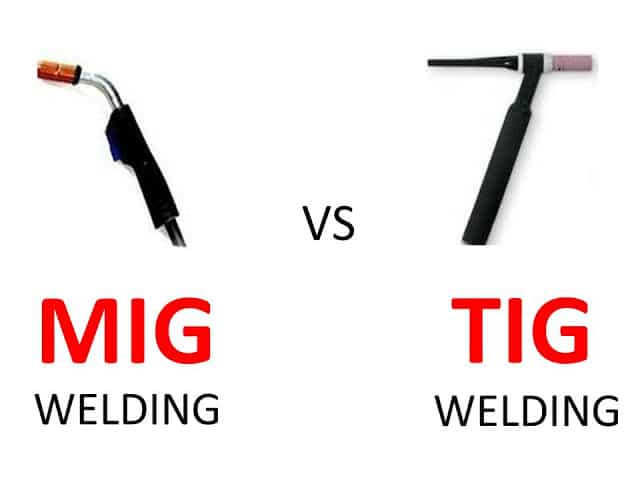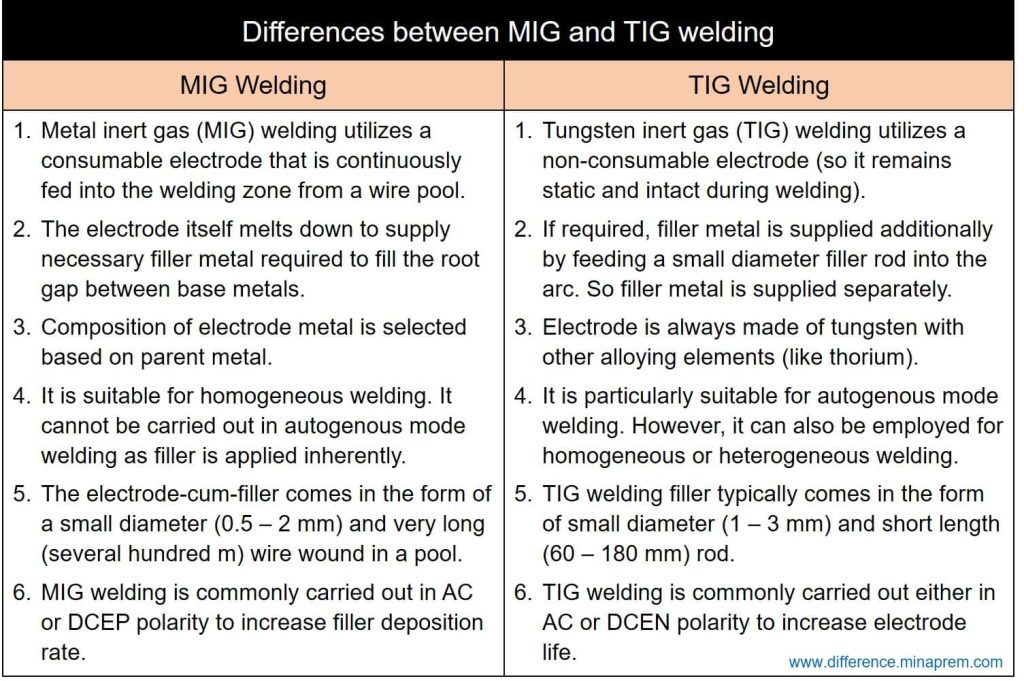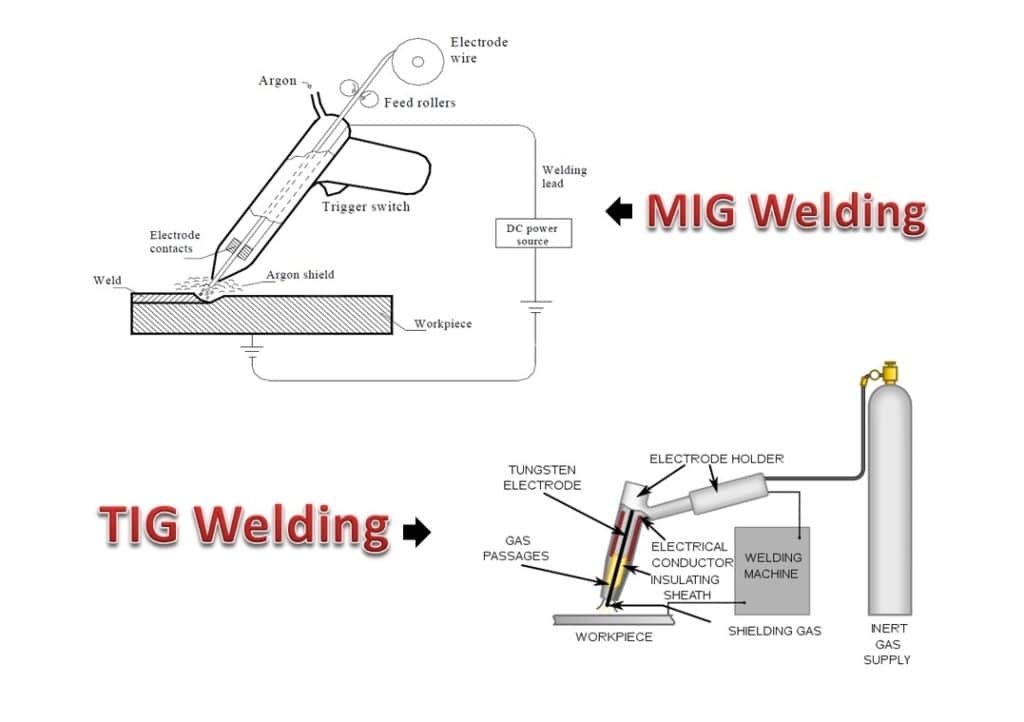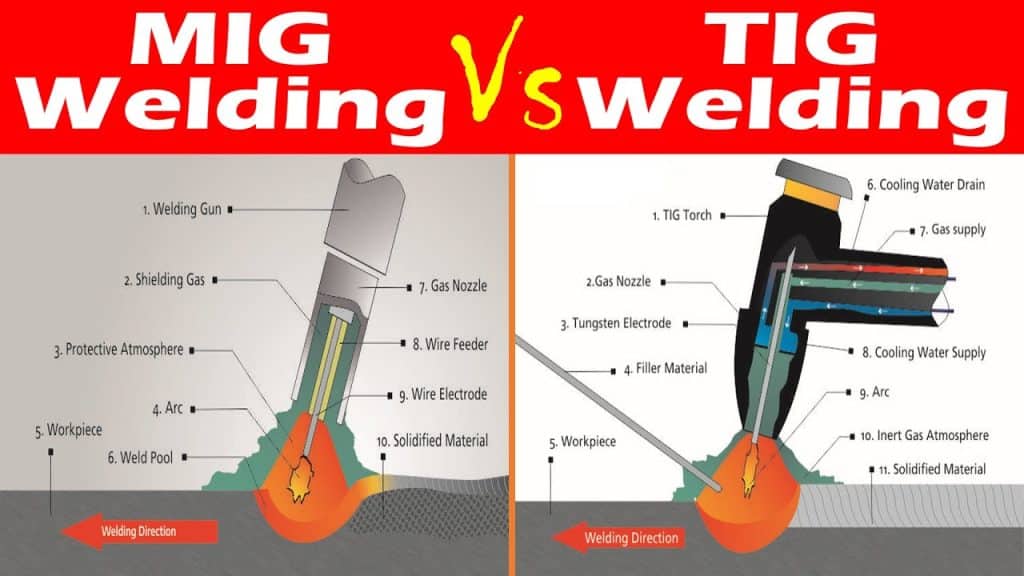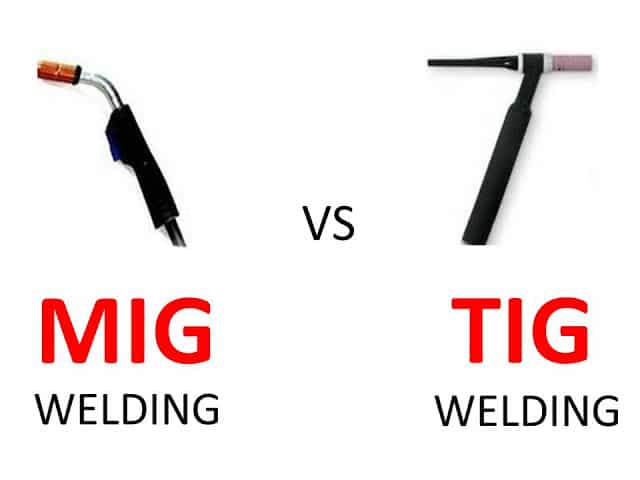In the world of welding, two commonly used techniques stand out: MIG and TIG welding. While both methods are used to bond metals together, they differ significantly in terms of their process and applications. MIG, or Metal Inert Gas welding, involves the use of a continuously feeding wire electrode and an inert gas shield to protect the weld from contamination. On the other hand, TIG, or Tungsten Inert Gas welding, employs a tungsten electrode and a separate filler metal to create a strong and precise weld. Understanding these differences is crucial for anyone in need of welding services or aspiring to become a skilled welder. Let’s delve into the realm of MIG and TIG welding to understand their unique characteristics and the best scenarios for each technique.
This image is property of www.difference.minaprem.com.
Review contents
What is MIG Welding?
Definition
MIG welding, also known as Metal Inert Gas welding, is a welding process that uses a continuous solid wire electrode and an inert gas to protect the weld pool from atmospheric contamination. This process is widely used in various industries such as automotive, construction, and manufacturing due to its versatility and ease of use.
Equipment
To perform MIG welding, a welding machine, a wire feeder, and a welding gun are essential equipment. The welding machine generates the electrical current required for the welding process, while the wire feeder feeds the electrode wire at a constant rate. The welding gun, connected to the wire feeder, directs the electrode wire to the weld area and supplies the shielding gas.
Process
MIG welding involves a straightforward process. The wire electrode is continuously fed from the welding gun while an inert gas, such as argon or a mixture of argon and carbon dioxide, is released to shield the weld pool from reacting with atmospheric oxygen and nitrogen. The electrical current passing through the wire electrode creates an arc, melting both the wire and the base metal. As the electrode wire is melted, it forms the weld bead, fusing the two pieces of metal together.
Advantages
MIG welding offers several advantages. Firstly, it allows for fast and efficient welding due to the continuous electrode feeding. Additionally, MIG welding can be used on a variety of materials, including stainless steel, aluminum, and mild steel. It also provides good control over the weld pool, allowing for precise and aesthetic welds. The use of an inert gas as a shielding agent minimizes the risk of porosity and defects in the welds, resulting in high-quality, strong welds.
Disadvantages
While MIG welding has many advantages, it also has some limitations. One of the notable disadvantages is the sensitivity to wind and drafts, which can disrupt the shielding gas, leading to weld defects. MIG welding may also result in a higher heat input, which can lead to distortion or warping of the base metal. Moreover, the use of filler wire in MIG welding can produce a larger weld bead compared to other welding processes, which can be undesirable in some applications, especially when aesthetics are a concern.
What is TIG Welding?
Definition
TIG welding, short for Tungsten Inert Gas welding, is a welding process that utilizes a non-consumable tungsten electrode to produce the weld. Unlike MIG welding, TIG welding does not use a continuously fed wire electrode, but rather requires the welder to manually feed the filler wire into the weld pool. This process is known for its precision, cleanliness, and ability to handle various metals.
Equipment
To perform TIG welding, one needs a TIG welding machine, a TIG torch, and a shielding gas source. The TIG welding machine provides the electrical current necessary for the welding process, while the TIG torch holds the tungsten electrode and allows precise control over the welding operation. A separate shielding gas source, such as argon, is required to protect the weld pool from oxidation and atmospheric contamination.
Process
TIG welding involves a more intricate process compared to MIG welding. The tungsten electrode, held in the TIG torch, creates an arc by generating an electrical current. This arc creates the heat needed to melt the base metal. To add filler material to the weld pool, the welder manually adds a filler wire, typically made of the same or compatible material as the base metal. The inert gas shield is simultaneously released through the TIG torch to protect the weld pool from atmospheric contamination.
Advantages
TIG welding offers several advantages, making it a preferred choice for many applications. One significant advantage is the precise control it provides over the weld pool, resulting in high-quality and aesthetically pleasing welds. TIG welding can be used on a wide range of materials, including stainless steel, aluminum, copper, and exotic alloys. The absence of a continuously fed electrode in TIG welding allows for intricate and detailed work. Furthermore, the use of a non-consumable tungsten electrode minimizes the chances of contaminating the weld pool.
Disadvantages
Despite its numerous advantages, TIG welding also has some drawbacks. Firstly, it can be a slower process compared to MIG welding due to the manual feeding of the filler wire. This can lead to reduced productivity when working on larger projects. Additionally, TIG welding requires a higher skill level as it necessitates precise control over the arc, filler material, and shielding gas. The complex nature of the TIG welding process also makes it more challenging for beginners to learn and master.
This image is property of 3.bp.blogspot.com.
Metal Inert Gas (MIG) Welding
Definition
Metal Inert Gas (MIG) welding, also referred to as Gas Metal Arc Welding (GMAW), is a welding process that utilizes a continuously fed wire electrode and an inert gas as a shielding agent. MIG welding is commonly used due to its speed, ease of use, and ability to handle a variety of materials.
Equipment
To perform MIG welding, several equipment pieces are required. A MIG welding machine, also known as a power source, provides the electrical current necessary for the process. A wire feeder, attached to the welding machine, continuously feeds the consumable electrode wire to the welding gun. The welding gun, connected to the wire feeder, supplies the shielding gas and directs the electrode wire to the welding area.
Process
MIG welding involves a straightforward process. The consumable electrode wire is continuously fed from the welding gun while an inert gas, such as argon or a mixture of argon and carbon dioxide, is released to shield the weld pool. The electrical current passing through the wire creates an arc, melting both the wire and the base metal. The molten wire acts as the filler material, fusing the two pieces of metal together and forming a weld bead.
Advantages
MIG welding offers several advantages, making it a popular choice for many welding applications. Firstly, it allows for high welding speeds and increased productivity due to the continuous wire feeding. MIG welding can be used on a wide range of materials, including steel, stainless steel, and aluminum. Furthermore, MIG welding provides good control over the weld pool, allowing for precise welding and achieving strong, reliable welds. This process also produces minimal spatter, reducing the need for post-weld cleanup.
Disadvantages
Despite its many advantages, MIG welding has some limitations. One of the main disadvantages is its sensitivity to wind and drafts. The shielding gas can be easily disrupted, resulting in poor weld quality and potential defects. MIG welding also tends to produce a larger weld bead compared to other welding processes, which may not be desirable in certain applications. Additionally, the higher heat input in MIG welding can lead to distortion and warping of the base metal, requiring additional post-welding procedures.
Tungsten Inert Gas (TIG) Welding
Definition
Tungsten Inert Gas (TIG) welding, also known as Gas Tungsten Arc Welding (GTAW), is a welding process that uses a non-consumable tungsten electrode to create an arc and the weld pool. TIG welding is valued for its precision, cleanliness, and ability to weld a wide range of materials.
Equipment
To perform TIG welding, specific equipment is required. A TIG welding machine, also referred to as a power source, generates the necessary electrical current. A TIG torch, held by the welder, houses the tungsten electrode and allows precise control over the welding operation. Additionally, a separate shielding gas source, usually argon, must be connected to provide the protective gas for the weld pool.
Process
TIG welding involves a more intricate and precise process compared to other welding methods. The tungsten electrode, held in the TIG torch, generates an arc by creating an electrical current. This arc produces the heat needed to melt the base metal. To add filler material to the weld pool, the welder manually feeds a filler wire into the weld area. The non-consumable tungsten electrode and the shielding gas prevent atmospheric contamination and oxidation of the weld pool.
Advantages
TIG welding offers numerous advantages that make it a popular choice for various applications. One of the key advantages is the precise control it provides over the welding process, allowing for high-quality and aesthetically pleasing welds. TIG welding can be used on a wide range of materials, including stainless steel, aluminum, copper, and exotic alloys. The absence of a continuously fed electrode in TIG welding enables detailed and intricate welding work. Additionally, the use of a non-consumable tungsten electrode minimizes the chances of contaminating the weld pool.
Disadvantages
Despite its advantages, TIG welding has some limitations. One of the main disadvantages is the slower welding speed compared to other processes due to the manual feeding of the filler wire. This can lead to reduced productivity, especially on larger projects. Additionally, TIG welding requires a higher skill level due to the need for precise control over the arc, filler material, and shielding gas. The complex nature of the TIG welding process also makes it more challenging for beginners to learn and master.
This image is property of qph.cf2.quoracdn.net.
Welding Process Comparison
Materials
Both MIG and TIG welding can work with a wide range of materials. MIG welding is commonly used for welding steel, stainless steel, and aluminum, while TIG welding is suitable for welding these materials and more, including copper, brass, and exotic alloys. Therefore, TIG welding offers greater versatility in terms of compatible materials.
Speed
In terms of welding speed, MIG welding is generally faster than TIG welding. The continuous wire feeding in MIG welding allows for a more rapid welding process, resulting in increased productivity. TIG welding, on the other hand, is a slower process as the welder manually feeds the filler wire into the weld pool.
Complexity
MIG welding is considered relatively easy to learn and operate, making it suitable for beginners and hobbyists. The continuous wire feeding and simplified process contribute to its simplicity. TIG welding, however, is a more complex process that requires a higher skill level. The precise control over the arc, filler material, and shielding gas demands more experience and practice for mastery.
Quality
Both MIG and TIG welding can produce high-quality welds when performed correctly. However, TIG welding generally provides better-quality welds. The precise control over the welding parameters, along with the absence of spatter and minimal heat input, contributes to TIG welding’s superior weld quality. MIG welding, while capable of producing strong welds, may exhibit more spatter and a larger weld bead, requiring additional post-weld cleanup.
Versatility
While both processes offer versatility, TIG welding is often favored for its ability to handle intricate and detailed welding work. The manual feeding of the filler wire and the precise control over the welding parameters make TIG welding suitable for applications that require aesthetic appeal and fine craftsmanship. MIG welding, although versatile, may not provide the same level of detail and control as TIG welding.
MIG vs TIG Welding
Application
The choice between MIG and TIG welding depends on the specific application requirements. MIG welding is commonly used in industries such as automotive manufacturing, construction, and general fabrication. Its high welding speeds and ease of use make it suitable for projects that prioritize productivity. TIG welding, on the other hand, is often preferred for applications that demand precision and aesthetic appeal, such as art, jewelry making, and aerospace industries.
Heat Input
In terms of heat input, TIG welding generally has a lower heat input compared to MIG welding. The precise control over the welding parameters in TIG welding allows for better heat management, reducing the risk of distortion and warping in the base metal. MIG welding, on the other hand, may generate higher heat due to the continuous wire feeding, which can result in increased heat input and potential base metal distortion.
Welding Speed
MIG welding is typically faster than TIG welding due to its continuous wire feeding. This makes MIG welding more efficient for larger projects where speed is crucial. TIG welding, while slower, offers better control and precision, making it suitable for detailed and intricate welding work.
Weld Appearance
In terms of weld appearance, TIG welding often produces cleaner and more aesthetically pleasing welds. The precise control over the arc, filler material, and shielding gas in TIG welding allows for smoother and more uniform welds. MIG welding, while capable of producing strong welds, may exhibit more spatter and a larger weld bead, requiring additional post-weld cleanup for a smooth appearance.
Skill Requirement
MIG welding is generally considered easier to learn and operate compared to TIG welding. The simplified process and continuous wire feeding make MIG welding suitable for beginners and hobbyists. TIG welding, however, requires a higher skill level due to the need for precise control over the welding parameters. The manual feeding of the filler wire and the complexities of the process demand more experience and practice for proficiency.
This image is property of i.ytimg.com.
Factors Influencing Choice
Material
The choice between MIG and TIG welding depends on the material being welded. While both processes can work with various metals, TIG welding offers greater versatility in terms of compatible materials. If the project involves materials such as copper, brass, or exotic alloys, TIG welding may be the preferred choice due to its ability to handle these materials.
Project Specifications
The specific requirements of the project play a significant role in determining the welding process. If speed and productivity are essential, such as in large-scale manufacturing or construction projects, MIG welding’s faster welding speeds may be preferred. For applications that demand precision, cleanliness, and aesthetic appeal, such as art or jewelry making, TIG welding’s superior control is often the better choice.
Cost
The cost of equipment, consumables, and maintenance can influence the choice between MIG and TIG welding. MIG welding typically requires less initial investment in equipment, making it more cost-effective for beginners or those on a limited budget. TIG welding, on the other hand, may have higher equipment costs, particularly due to the need for a TIG welding machine and a TIG torch. Additionally, the cost of consumables, such as electrode wire and filler rod, should be considered when comparing the overall costs.
Weld Quality
The desired weld quality also impacts the selection of welding process. If high-quality and aesthetically pleasing welds are of utmost importance, TIG welding is often the preferred choice. TIG welding’s precise control over the welding parameters and its ability to produce clean, spatter-free welds make it suitable for applications where weld appearance is critical. However, if the project primarily focuses on strong and reliable welds, MIG welding can provide satisfactory results.
Operator Skill
The skill level and experience of the operator should not be overlooked when choosing between MIG and TIG welding. MIG welding, with its simplified process and continuous wire feeding, is generally more accessible for beginners and those with limited welding experience. TIG welding, on the other hand, requires a higher skill level due to its complex nature and the need for precise control over the welding parameters. Operators with more experience and proficiency in welding may prefer the challenges and aesthetic advantages of TIG welding.
Common Applications
MIG Welding Applications
MIG welding finds applications in various industries. It is commonly used in automotive manufacturing for welding car frames, body panels, and exhaust systems. The construction industry also utilizes MIG welding for welding structural components, fences, and gates. In the manufacturing sector, MIG welding is employed for fabricating metal products, furniture, and appliances. Additionally, MIG welding is used for welding aluminum in the aerospace industry.
TIG Welding Applications
TIG welding’s ability to provide precise control and high-quality welds makes it suitable for a range of applications. In the aerospace industry, TIG welding is employed for welding critical components such as aircraft frames, engine parts, and fuel systems. The art and jewelry-making industries also utilize TIG welding for creating intricate and detailed welds on sculptures, jewelry pieces, and decorative metalwork. TIG welding is also commonly used in the food and beverage industry, where cleanliness and hygiene are essential, as it produces clean and spatter-free welds.
This image is property of mechanical-engineering.s3.amazonaws.com.
Choosing the Right Welding Technique
Project Requirements
When choosing the right welding technique, it is crucial to consider the specific requirements of the project. Factors such as the material being welded, the desired weld appearance, the project specifications (speed, productivity), and the quality requirements are all important considerations. Assessing these project-specific factors will help determine whether MIG or TIG welding is the most suitable choice.
Material
The material being welded plays a significant role in selecting the welding technique. As mentioned earlier, MIG welding is commonly used for steel, stainless steel, and aluminum, while TIG welding is suitable for these materials and more. If the project involves materials such as copper or exotic alloys, TIG welding may be the preferred technique due to its versatility.
Skill Level
The skill level of the operator is another crucial factor to consider. If the operator is a beginner or has limited welding experience, MIG welding may be the more accessible and easier option to learn. However, if the operator has experience and proficiency in welding or if precise control and quality are paramount, TIG welding may be the better choice.
Conclusion
In conclusion, both MIG and TIG welding are widely used and highly versatile welding techniques. MIG welding offers high welding speeds, ease of use, and is suitable for a range of materials. On the other hand, TIG welding provides precise control, clean welds, and is favored for applications that demand aesthetic appeal and high-quality craftsmanship. The choice between MIG and TIG welding depends on various factors, including the material, project requirements, cost, weld quality, and operator skill. By understanding the differences and considering these factors, one can choose the appropriate welding technique for each specific project.

